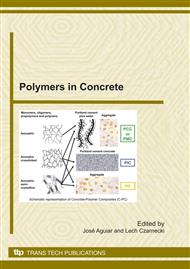p.57
p.65
p.73
p.85
p.97
p.105
p.115
p.121
p.131
Influence of Environmental Temperatures on the Performance of Polymeric Stabilising Agent in Fresh Cementitious Materials
Abstract:
Stabilising admixtures are commonly used additives in repair mortars and grouts. Beyond this, such type of admixture is increasingly used in concrete and other cementitious materials. In particular when fresh mortar or concrete properties have to be adjusted reliably, stabilising agents can be beneficially used to improve workability and robustness of the mixture. The mode of operation of these admixtures varies, rather affecting either the liquid phase or the solid particles in the dispersion, both causing strong interactions with the mortar or concrete system, and significant changes in their rheological behaviour. Furthermore, these are strongly affected by the environmental temperature during the casting process. In the paper the effect of temperature on the performance of stabilising agents in cementitious systems is presented and how performance changes affect fresh and hardening mortar or concrete properties. Particular attention is placed on interactions between stabilising agents and superplasticizers. Results are discussed with special focus on self-compacting concrete.
Info:
Periodical:
Pages:
97-104
Citation:
Online since:
January 2011
Price:
Сopyright:
© 2011 Trans Tech Publications Ltd. All Rights Reserved
Share:
Citation:


